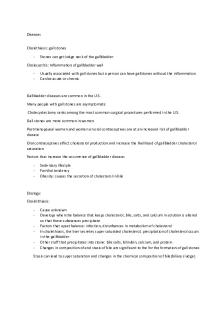Opsonisation, MAC, Cytolysis, Inflammation PDF

| Title | Opsonisation, MAC, Cytolysis, Inflammation |
|---|---|
| Author | Diogo Cunha |
| Course | Principles of Immunology |
| Institution | University of Hertfordshire |
| Pages | 2 |
| File Size | 52.1 KB |
| File Type | |
| Total Views | 153 |
Summary
Principles of Immunology...
Description
Opsonisation - After “Central Event”, C3b molecules are produced , a reactive thioester becomes exposed in C3b which bind to microbial surfaces o Reacts with proteins and carbohydrates o They bind to “unprotected microbial surfaces”, that is why C3b cant bind to our “protected” cell surfaces - Phagocytes have receptors for C3b and will recognise it. C3b is called an “Opsonin” - Opsonins promote phagocytic cell function - Microbial cells that are have opsonins are more readily phagocyted, therefore: o Increases rate of phagocytosis o Increases rate of microbial clearance
MAC-mediated Cytolysis - C5b6789(n) assemble to form the Membrane Attack Complex - Formation of a “fully active C9 ring” is accomplished by binding of 12-18 copies of C9, forming a transmembrane pore, and disrupts of membrane o External face of the pore is hydrophobic which allows to interact with membrane o Internal face of the pore is hydrophilic which allows free diffusion of water and other molecules in and out of microbe o Many pores formed will make it impossible for the microbe to survive which results in uncontrolled of influx of ions and water, osmotic lysis - Because MAC associates with phospholipid bilayer, it is more effective with gram-negative bacteria, nucleated cells, and enveloped viruses
Inflammation - Action on Mast Cells and Basophils o Complement components involved: C5a, C3a, C4a (anaphylatoxins) o C5a about 20 times more potent than C3a, and 2500 times more potent than C4a o They are anaphylatoxins (or pro-inflammatory mediators) because they activate other cells o These anaphylatoxins produce localised inflammatory responses via degranulation of mast cells and basophils Degranulation – is the release of substances of those cells These substances are more inflammatory mediators, like Histamine, (or prostaglandins, etc) Histamines causes enhanced blood vessels permeability to other plasma components and leukocytes to the site of infection...
Similar Free PDFs

Chronic inflammation
- 3 Pages

6. Phagocytosis & Inflammation
- 1 Pages

Pain and Inflammation
- 3 Pages

Pathophysiology of Inflammation
- 2 Pages

Module-3-Inflammation
- 27 Pages

Magic Draw MAc - Instalar en MAC
- 10 Pages

MAC - apuntes acerca de mac- os
- 6 Pages
Popular Institutions
- Tinajero National High School - Annex
- Politeknik Caltex Riau
- Yokohama City University
- SGT University
- University of Al-Qadisiyah
- Divine Word College of Vigan
- Techniek College Rotterdam
- Universidade de Santiago
- Universiti Teknologi MARA Cawangan Johor Kampus Pasir Gudang
- Poltekkes Kemenkes Yogyakarta
- Baguio City National High School
- Colegio san marcos
- preparatoria uno
- Centro de Bachillerato Tecnológico Industrial y de Servicios No. 107
- Dalian Maritime University
- Quang Trung Secondary School
- Colegio Tecnológico en Informática
- Corporación Regional de Educación Superior
- Grupo CEDVA
- Dar Al Uloom University
- Centro de Estudios Preuniversitarios de la Universidad Nacional de Ingeniería
- 上智大学
- Aakash International School, Nuna Majara
- San Felipe Neri Catholic School
- Kang Chiao International School - New Taipei City
- Misamis Occidental National High School
- Institución Educativa Escuela Normal Juan Ladrilleros
- Kolehiyo ng Pantukan
- Batanes State College
- Instituto Continental
- Sekolah Menengah Kejuruan Kesehatan Kaltara (Tarakan)
- Colegio de La Inmaculada Concepcion - Cebu








